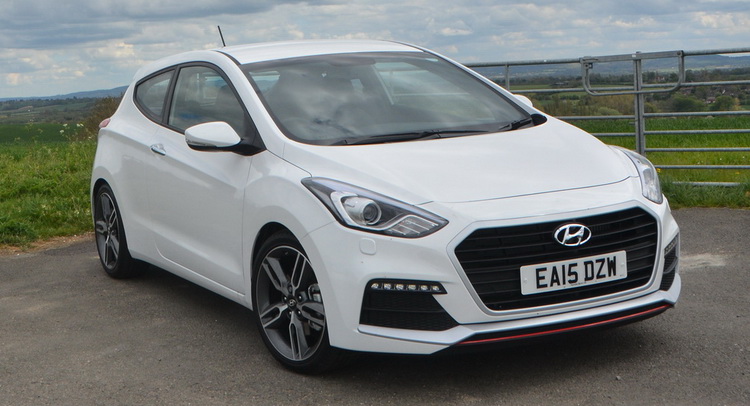This is Hyundai’s debut into the warm hatch corner of the C Segment, the 183hp 1.6-litre i30 Turbo.
Unlike going for a full-blown hot-hatch to rival directly cars like the Golf GTI, Hyundai preferred to dip its toe first, installing the turbocharged 1.6-litre GDI petrol engine from the now discontinued Veloster Turbo in the facelifted i30. But don’t assume that this is a half-baked solution, because Hyundai took the time to develop the suspension settings in the ultimate road course, the Nurburgring.
What’s changed?
Visually, apart from the latest hexagonal grille, the i30 Turbo has gained a sportive body kit, twin exhausts, 18in wheels and LED rear lights. On the inside you get some red detailing, a leather steering wheel and a set of sportier two-tone seats.
With 183hp at 5500rpm and 195lb-ft (265Nm) of torque available between 1500-4500rpm, the i30 Turbo is capable for a 0-62mph (100km/h)1 in 8 seconds and a top speed of 136mph (218km/h). It will not blow your socks off but then again you wouldn’t expect it to do so. CO2 emissions are rated at 169g/km while Hyundai claims a 38.7mpg UK (32.2mpg US or 7.3 l/100km) combined fuel economy. The market places the i30 Turbo among similarly oriented cars like the 178hp Seat Leon FR 1.8TSI, the 202hp Peugeot 308 GT and of course its cousin, the 201hp Kia Cee’d GT.
How does it drive?
It’s rather good. The chassis offers a lot of grip and the suspension keeps the body under control at all times without ruining the ride, revealing the fine work Hyundai has done in tuning the dampers. Even on a poor-quality surface, the i30 Turbo retains its compliant composure, filtering out bumps and potholes.
And as the numbers suggested, the i30 Turbo is quick but never feels like a pocket-rocket. Keep it on boil with the short-throw gearbox though and the sporty Hyundai follows you loyally, helped by its entertaining agility and progressiveness. The chassis is dealing the available power without any effort and that allows you to thrash the i30 Turbo easier and for longer periods.
The steering offers three different setups -Comfort, Normal and Sport- but even with the latter engaged, it lacks the communication skills you expect from a fun car like this. This isn’t a fully-fledged hot hatch though, just a sharper i30 with the whole balance between everyday commuting and the occasional spirited driving being very well executed.
Bottom Line
Hyundai is offering one level of equipment for the i30 Turbo and comes fully loaded with nearly everything: Bluetooth, cruise control, sat-nav, dual-zone climate control, half-leather heated sports seats, 18in wheels and a rear view camera among others. You can also have one in a 5-door form, further increasing its practicality.
Some rivals may not offer the same kit as standard, others may be more expensive but they remain a bit faster and CO2-cleaner too like the Seat Leon FR 1.8TSI and the Peugeot 308GT. Prices start at £22,500 for the three-door and £23,000 for the five-door version, which when combined with the rich equipment levels, make the Hyundai i30 Turbo a solid all-rounder and a charming alternative for those who are looking to spice up their everyday commuting.






































































